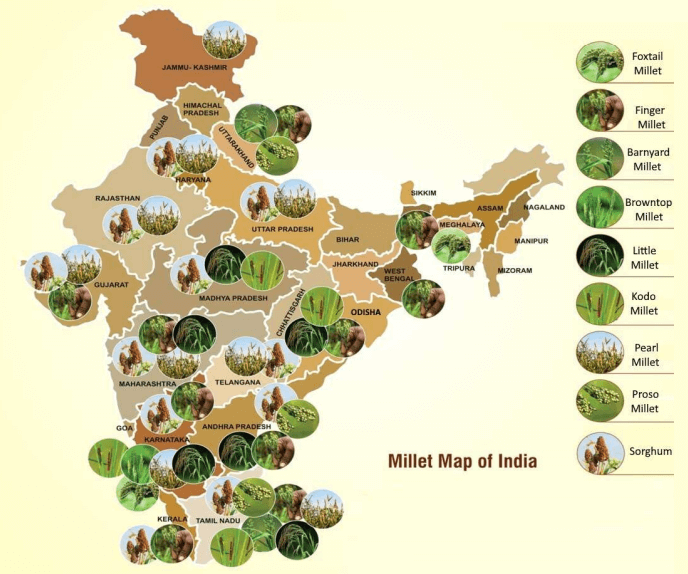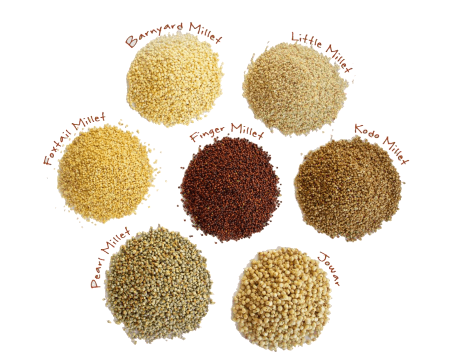Millets – The Superfood of India
Millets are one of the oldest food grains known to mankind and possibly the first cereal grain used for domestic purposes. the earliest evidence for these grains has been found in Indus Valley Civilization but due to the push given to food security through Green Revolution in the 1960s, millets were rendered as ‘orphan crops’ – less consumed and almost forgotten.
Many events were launched to create awareness and a sense of participation in the country around the ancient and forgotten golden grains.
International Year of Millets: 2023
Recognizing the importance of millets, and creating a domestic and global demand along with providing nutritious food to the people, the Government of India, spearheaded the United Nations General Assembly (UNGA) resolution for declaring the year 2023 as International Year of Millets.
The proposal of India was supported by 72 countries, and UNGA declared 2023 as the International Year of Millets in March 2021.
What are Millets?

Millets are small-seeded, annual, warm-weather cereals belonging to the grass family. Jowar (Sorghum), Bajra (Pearl Millet) and Ragi (Finger millet) are the important millets cultivated in India. Small Millets such as Proso (Cheena), Kodo (Kodra, Arikelu), Fox tail (Kangni/Korra), Barnyard (Varai, Sawa), Little millet (Kutki) are also grown in our country.
An important staple cereal crop for millions of smallholder dryland farmers across Sub-Saharan Africa and Asia, millets offer nutrition, resilience, income and livelihood for farmers. They have multiple untapped uses such as food, feed, fodder, biofuels and brewing. Therefore, millets are Smart Food as they are Good for Consumers, Good for the Farmer and Good for the Planet
It is grown in about 131 countries and is the traditional food for around 59 crore people in Asia & Africa.
India is the largest producer of millet in the world.
The leading millet producing (top ten) states are Rajasthan, Uttar Pradesh, Gujarat, Madhya Pradesh, Haryana, Maharashtra, Karnataka, Tamil Nadu, Odisha and Kerala.
Importance of Millets : Significance and Benefits

- Millets are rich sources of nutrients like carbohydrates, protein, dietary fibre, and good-quality fat and have substantially higher amounts of minerals like calcium, potassium, magnesium, iron, manganese, zinc and B complex vitamins. their micro-nutrients composition is also better as compared to rice or wheat.
- Millets can also help tackle health challenges such as obesity, diabetes and lifestyle problems as they are gluten-free, have a low glycemic index and are high in dietary fibre and antioxidants. Millets also contain various phytochemicals which exert therapeutic properties owing to their anti-inflammatory and anti-oxidative properties.
- Millets are the backbone for dry land agriculture. It require fewer inputs and labour with low water requirement and generally of short duration (90-180 days) than other cereals. They are hardy, resilient crops that have a low carbon and water footprint.
- Millet production is not dependent on the use of chemical fertilizers. These crops do not attract pests, and most of the millets are not affected by storage pests. Thus, the use of pesticides is also not mandated.
- Millets are cultivated mostly in marginal soils. Mostly resource poor farmers such as tribal farmers do cultivation. They are highly tolerant to drought and other extreme weather conditions and have in-built resilience to climate change impacts
- Millets act as live mulch, which helps in conservation of moisture, maintaining microbial population in the rhizosphere, etc. thereby improving soil health.
- Millets are also a good source of fodder to meet livestock needs.
1. Finger Millet (Ragi)
Finger Millet, popularly known as Ragi, is commonly consumed by fitness enthusiasts as a healthier alternative to rice and/or wheat. It is a gluten-free variant of Millet, rich in proteins and amino acids. In growing children, finger millet is intended to facilitate brain growth. It is also high in calcium and has healthy concentrations of iron and other minerals as well. Ragi also has a good number of essential amino acids essential for the human body in the antioxidant activity of traditional Indian foods.
2. Foxtail Millet (Kakum/Kangni)
Foxtail Millet, also known as Kakum/Kangni in India, is usually available in Semolina or rice flour. It is rich in carbohydrates that helps in balancing blood sugar levels in the body. Foxtail Millet can improve overall immunity. Foxtail Millet is the closest to rice. It is most commonly used as a substitute for rice across the world.
3. Sorghum Millet (Jowar)
This is yet another popular type of Millet in India to make Rotis and other bread. It is locally known as Jowar. Organic jowar is a rich source of iron, protein, and fibre and, because of the presence of policosanols, can help lower cholesterol levels. People with wheat allergies can have Jowar as a healthier alternative. Jowar also has more antioxidants than blueberries and pomegranates and is rich in calories and macronutrients. Sorghum helps increase metabolism.
4. Pearl Millet (Bajra)
Pearl millet or Bajra is one of the most common types of millets that you must have tasted. It is prepared in various ways, including roti and khichdi, with immense health benefits. Bajra includes iron, fibre, protein, and minerals such as magnesium and calcium. It can be perfect for your well-being to practice regular pearl millet intake, such as helping you battle type II diabetes.
5. Buckwheat Millet (Kuttu)
Buckwheat, also known as Kuttu in India, is one of the most common types of Millet and is often used during the Navratra fasting time. It is diabetic-friendly and helps in reducing blood pressure. It is helpful for good cardiovascular health, and if you want to lose weight, it should be integrated into your diet. Buckwheat also protects against cancer of the breast, asthma in children, and gallstones.
6. Amaranth Millet (Rajgira/Ramdana/Chola)
You must have heard about the incredible benefits of Amarnath Oats. But do you know that Amarnath, also known as Rajgira, Ramdana, and Chola, is a types of Millets? This Millet is rich in protein and dietary fibre. It is great for a healthy diet. This Millet also helps in fighting greying and hair loss. Amaranth also lowers cholesterol levels and cardiovascular disease risk. Calcium, vitamins, and other minerals are high in it.
7. Little Millet (Moraiyo/Kutki/Shavan/Sama)
Little Millet is one of the major in list of millets, it is also called Moraiyo, Kutki, Shavan, and Sama. It is loaded with vitamin B and essential minerals such as Calcium, Iron, Zinc, and Potassium. Little Millet is largely used in Southern states of India in numerous traditional dishes. It is a healthier alternative to rice and does not cause weight gain.
8. Barnyard Millet
Barnyard Millet is popular in millets name list and also known as Sanwa. It is stacked with high amounts of dietary fibres that help improve bowel movement and aiding weight loss. It is rich in calcium and phosphorus, which can strengthen bone density.
9. Broomcorn Millet
Popularly known as Chena in India, Broomcorn helps balance blood sugar levels as it has a low glycemic index. It is a good option for diabetics to be incorporated into a daily diet. Switching to a diet with Millet can be a good transformation as far as nutrition is concerned.
10. Kodo Millet
Kodo Millet, also known as Kodon Millet, is a digestible variant with higher amounts of lecithin amino acid. It has a significant effect on strengthening the nervous system. Kodo is a fantastic source of B vitamins, especially niacin, B6, and folic acid, among other vitamins and minerals. It contains calcium, iron, potassium, magnesium, and zinc minerals. Being a gluten-free millet, it is great for gluten- intolerant individuals. It can relieve cardiovascular disorders such as high blood pressure and cholesterol levels when eaten regularly by postmenopausal women. Kodo millet and small Millet have 37% to 38% dietary fibre, which is the highest among cereals.




Awesome! Its genuinely remarkable post, I have got much clear idea regarding from this post